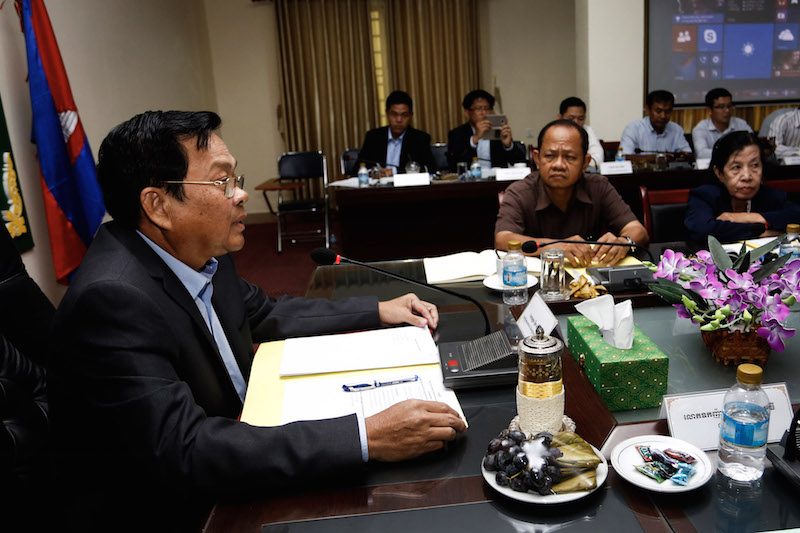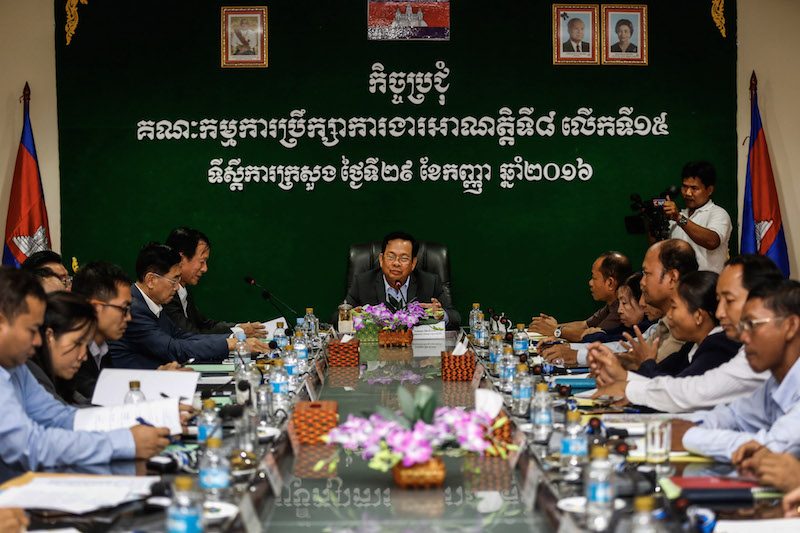The government raised the monthly minimum wage for the country’s dominant garment sector from $140 to $153 on Thursday amid growing concerns of shrinking profit margins and after months of negotiations that left unions and factory owners far apart.
The new wage, part of the government’s recent commitment to incremental annual raises after years of stagnation, will take effect in January.

The Labor Advisory Committee (LAC)—composed of union, employer and, mostly, government representatives—saw 22 of its 24 members present vote in favor of the government’s proposal to raise the minimum wage to $148. A proposed raise to $171 from the unions secured two votes and a raise to $147, put forward by employers, received none.
Labor Minister Ith Sam Heng said Prime Minister Hun Sen then topped off the winning number with another $5.
“The result of our voting today is overwhelmingly in support of $148 and the head of the government…decided to add $5 more. So the minimum wage in 2017 is $153,” Mr. Sam Heng told reporters at the Ministry of Labor in Phnom Penh.
He said he hoped the new wage struck a fair balance between the hopes of employers and employees, all 600,000 of them, alike.
“I think we cannot satisfy everyone 100 percent, but it’s better than what we had before,” he said.
Independent union leader Ath Thorn said he was one of the two LAC members to vote for the raise put forward by the unions in what may have looked like a show of unity at first, only for most of them to abandon the demand on Thursday.
He said the new wage did not come close to covering the cost of living most garment workers face, which a recent study commissioned by unions pegged at nearly $200 a month.
“We are not satisfied with this wage because we think it cannot pay for a suitable living,” he said. “I think some workers will be happy with it and some will not, but most workers want at least $171.”
“Whether there will be protests will depend on discussions with the workers, but I think protesting this time will be a bit difficult,” Mr. Thorn added.
“We, the negotiators, are under court supervision and workers are having a hard time protesting lately because of restrictions from employers and authorities,” he said, citing firings, arrests and competing protests from rival unions.

Garment workers have been far more reluctant to protest for higher wages since police put down a violent demonstration outside a Phnom Penh factory in 2014 by firing live rounds into the crowd, killing at least five people. And charged for allegedly instigating the violence, union leaders have been less willing to lead them. Since then, the government has also agreed to raise the minimum wage at least a little each year and to give independent unions a louder voice in the wage-setting process.
Van Sou Ieng, chairman of the Garment Manufacturers Association in Cambodia (GMAC), which represents exporting factories, said the latest raise would mean the loss of the cheapest garment orders to rival countries with lower labor costs.
“We will try to survive,” he said. “Cheap items will not be produced in Cambodia…. So we will try to add value in Cambodia.”
Employers have blamed an uptick in shuttered factories squarely on the raises in the minimum wage over the last few years, and Mr. Sou Ieng said closures would likely continue apace barring any changes to broader market forces. And though exports have continued to see strong year-on-year growth, bucking GMAC’s warnings of a decline, the chairman said the days of double-digit growth were over.
In its latest bulletin on Cambodia’s garment industry, the International Labor Organization also warned that investment in the sector would soon start to drop off unless the last few years of raises were met with similar gains in productivity or brands ready to pay more for their orders.
Mr. Sou Ieng said the factories were trying to raise worker productivity, among the lowest in the region, but felt stymied by the multitude of trade unions and their wildcat strikes.
“It’s not possible to manage a country with more trade unions than enterprises,” he said. “It’s not sustainable.”
Some unions, in turn, blame employers for investing too little in their workers.
William Conklin, country director of the Solidarity Center, a U.S. labor rights group, said raising productivity rested first and foremost with the factory owners.
“They have the ability to make better work environments: investing in better machinery, work stations and workplaces; setting up canteens and providing meals, and addressing the transport situation—workers come in after a long, harrowing ride and face the same one going back at night,” he said. “[They should] move from treating labor as a commodity to that of an asset that they value.”
Even so, Mr. Conklin, who works closely with local unions, said he expected the new minimum wage to spark little protest. Backed up by the threat of force, the government may once again have given workers just enough to keep them off the streets.
“[The government] for now has gotten what it wants,” Mr. Conklin said, “the new [minimum wage] figure with little pushback by non-CPP unions.”




